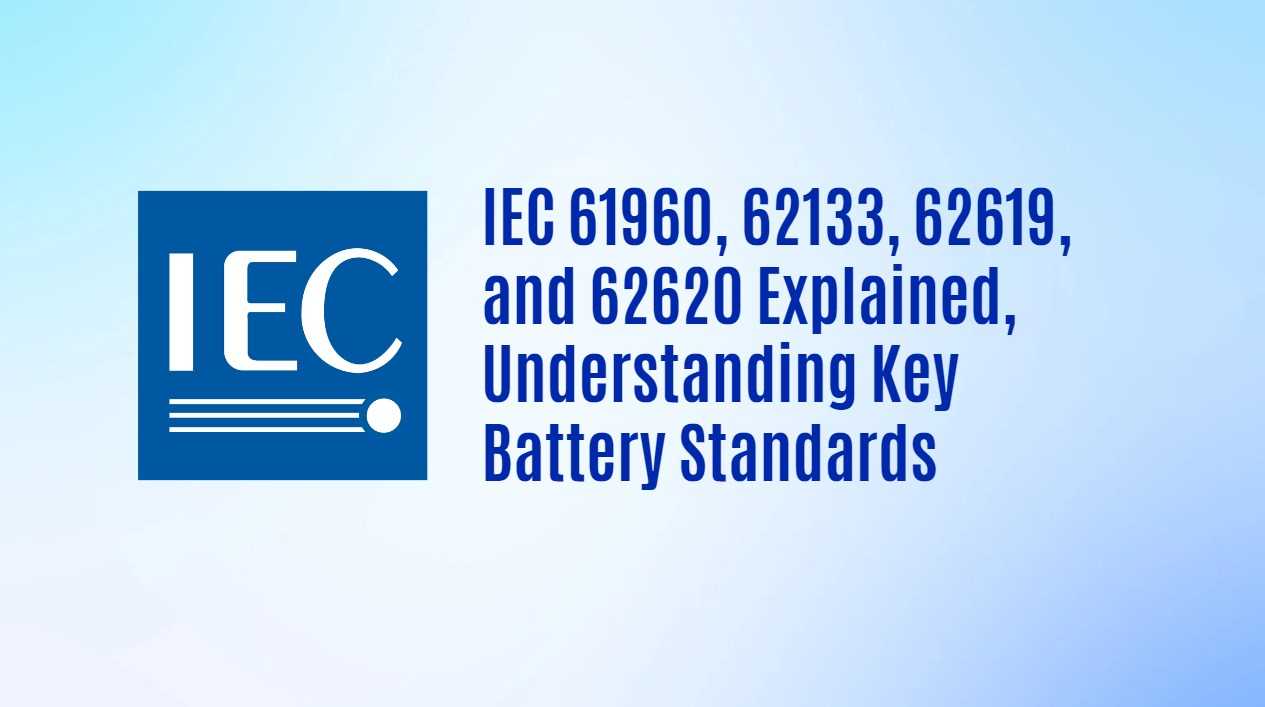In the rapidly evolving world of battery technology, standards play a crucial role in ensuring safety, performance, and compatibility. The IEC (International Electrotechnical Commission) has established several key standards, including IEC 61960, IEC 62133, IEC 62619, and IEC 62620, which govern the design, testing, and use of lithium batteries. This guide will provide an overview of these standards and their significance.
1. IEC 61960
Overview
IEC 61960 specifies performance tests, designations, markings, dimensions, and other requirements for secondary lithium cells and batteries used in portable applications. This standard is essential for manufacturers and users to assess the performance characteristics of lithium batteries.
Key Features
- Performance Testing: Establishes criteria for evaluating battery performance under various conditions.
- Designations and Markings: Provides guidelines for labeling batteries to ensure clear identification of specifications.
- Application Scope: Focuses on portable applications, including consumer electronics and power tools.
Updates
The most recent edition, IEC 61960-4:2020, expands on the original by including specifications for coin-type lithium cells and batteries used in applications such as memory backup.
2. IEC 62133
Overview
IEC 62133 addresses safety requirements for portable sealed secondary cells and batteries containing alkaline or other non-acid electrolytes. This standard is crucial for ensuring that lithium-ion batteries are safe for consumer use.
Key Features
- Safety Testing: Outlines rigorous safety tests to prevent hazards like overheating, leakage, and explosions.
- Compatibility: Ensures that batteries can be safely used in various devices without risk to users or equipment.
- Design Guidelines: Provides recommendations for battery design to enhance safety features.
Applications
This standard is widely applicable across various industries, including consumer electronics, electric vehicles, and renewable energy systems.
3. IEC 62619
Overview
IEC 62619 focuses on the safety requirements for secondary lithium-ion cells and batteries used in industrial applications. This standard is particularly relevant for larger battery systems used in electric vehicles and energy storage systems.
Key Features
- Safety Protocols: Establishes comprehensive safety protocols to mitigate risks associated with high-capacity lithium-ion batteries.
- Testing Procedures: Includes detailed testing procedures to evaluate thermal stability and electrical performance.
- Regulatory Compliance: Helps manufacturers meet international regulatory requirements for industrial battery systems.
Importance
As the demand for large-scale energy storage solutions increases, adherence to IEC 62619 ensures that these systems operate safely and efficiently.
4. IEC 62620
Overview
IEC 62620 specifies the performance requirements for secondary lithium-ion cells used in stationary applications. This standard is vital for ensuring the reliability of batteries deployed in energy storage systems.
Key Features
- Performance Criteria: Defines performance criteria to ensure that stationary batteries can withstand environmental stresses.
- Durability Testing: Includes tests for longevity and reliability under various operating conditions.
- Standardization: Promotes uniformity in battery design and performance across manufacturers.
Applications
This standard is critical for stationary energy storage solutions used in renewable energy systems, grid stabilization, and backup power applications.
Latest Trends in Battery Standards
- Sustainability Focus: Recent updates to these standards emphasize environmentally friendly practices in battery production and disposal.
- Technological Advancements: Ongoing innovations in battery technology are leading to new safety features and performance enhancements that are reflected in updated standards.
- Global Harmonization: Efforts are underway to harmonize international standards to facilitate global trade and ensure consistent quality across markets.
Redway Expert Comment
As experts in lithium LiFePO4 battery technology, we recognize the importance of adhering to established standards like IEC 61960, 62133, 62619, and 62620. These standards not only enhance safety but also improve overall battery performance across various applications. Staying informed about these regulations is essential for manufacturers aiming to meet market demands while ensuring user safety.”
Conclusion
Understanding IEC standards such as 61960, 62133, 62619, and 62620 is crucial for anyone involved in the production or use of lithium batteries. These guidelines ensure that batteries are safe, reliable, and efficient across a range of applications—from portable electronics to large-scale energy storage systems. By adhering to these standards, manufacturers can enhance product quality while consumers can enjoy safer battery-powered devices.



